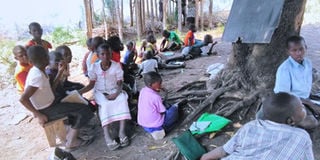60% of pupils in Kakumiro cannot read well - Uneb survey

Pupils of St Balikudembe Primary School in Kakumiro District studying under a mango tree recently. FILE PHOTO
What you need to know:
- The survey found that 23 out of the 122 districts surveyed were able to rate above 75 per cent in terms of literacy proficiency in Primary Three at the national level. These included Mitooma, Kampala, Mbarara, Sheema, Kiruhura, Wakiso, Bushenyi, Ibanda, Buhweju and Masaka, among others.
Kakumiro. A survey carried out by Uganda National Examinations Board (Uneb) has found that Kakumiro District is still performing poorly in numeracy and literacy levels at primary level.
The report from a 2018 survey in 122 districts under the National Assessment Progress in Education (NAPE) programme released this week indicates that only 36.1 per cent of Primary Three pupils were rated proficient in numeracy.
Only 27.3 per cent of Primary Three pupils were rated proficient in literacy, implying that they can read and write familiar words and sentences.
The survey also showed that only 28.3 per cent of Primary Six pupils were proficient in numeracy and 38.3 per cent in literacy.
Thirteen schools from each district were sampled and a total of 31,362 Primary Three and 30,957 Primary Six pupils were tested for numeracy and literacy levels.
Proficiency in numeracy meant that Primary Six pupils could solve word problems with addition, subtraction and work on fractions.
They could also calculate mean, average, perform operations and geometric construction.
Averagely, more than 60 per cent of Primary Three and Primary Six pupils cannot write, read and work with numbers.
While presenting the results to district leaders, Ms Josephine Nasonko, the NAPE programmes coordinator from Uneb, said the survey was meant to test the learners’ numeracy and literacy levels in the selected schools.
‘‘It was meant to evaluate the effectiveness of reforms in the education systems such as early grade reading. We have been conducting NAPE since 2016. It is also meant for suggesting measures for improvement learning and teaching in schools,’’ Ms Nasonko said.
The survey also found out that teachers had difficulties in writing informal letters with correct format, failure to debate with appropriate language and creating adequate content on topics.
The pre-service teachers had problems in Mathematics, especially in interpreting graphs, multiplying fractions and measurements.
Ms Mary Kyofuna, the district inspector of schools, urged schools to restore co-curricular activities such as debates.
“The results have not made us happy and we have drawn a road map on how we can improve. We have resolved that all schools should restore co-curricular activities so that pupils can learn how to express themselves. We need effort from all stakeholders,’’ Ms Kyofuna said.
Mr James Kibuuka, a teacher in Kakindo Sub-county, attributed poor performance to lack of teaching materials.
Mr Sunday Eden, a teacher at Kakumiro Public Primary School, blamed the gaps on absenteeism of learners.
He also said some pupils lack key scholastic materials such as geometry sets.
Mr Joseph Ajuna, the district speaker, urged parents to encourage their pupils to perform better.
About 48 percent of pupils were reported to be coming late to school because of engagements in activities like harvesting, fishing and gardening.
Best and worst
The survey found that 23 out of the 122 districts surveyed were able to rate above 75 per cent in terms of literacy proficiency in Primary Three at the national level. These included Mitooma, Kampala, Mbarara, Sheema, Kiruhura, Wakiso, Bushenyi, Ibanda, Buhweju and Masaka, among others. The worst performing districts rated under 25 per cent in literacy are Kaberamaido, Alebtong, Tororo, Pader, Moyo and Apac, among others.




